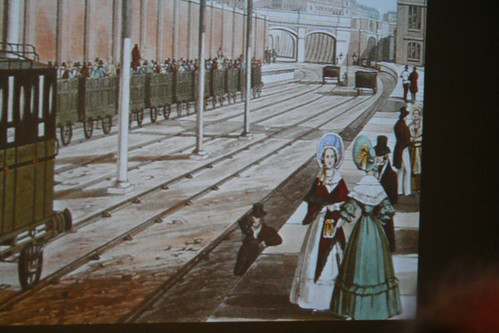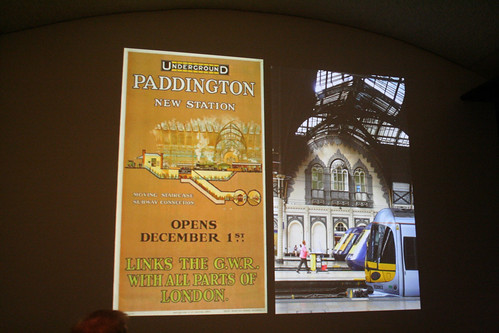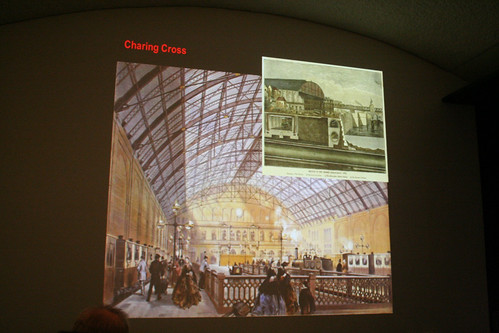Tuesday evening found the subterranean lecture hall at the Transport Museum almost filled up as Oliver Green gave an introductory talk about his latest pocket book – and it is actually designed to fit in a pocket – about the mainline terminus stations in London.
The guide is designed to be a circular guide to the mainline stations starting from Paddington and running clockwise around the Circle Line – with the occasional diversion south of the river – so people can travel around and visit each station in turn.
During the talk though, he went in chronological order instead, and gave a brief history of each of the stations, starting naturally at London Bridge, which was the first mainline station to arrive in London.
Initially though, the station was just a shed type building and it wasn’t until later through several versions that the main Victorian structure that makes up half the station today was built. This “shed” is now listed, but there are plans to demolish it and tidy up the sprawling mess – but only if they can find someone who wants the building somewhere else.
Euston though was the first truly inter-city rail terminus in London, but at the time of its construction, a major flaw turned up as the station is at the bottom of a fairly steep approach. Great for trains approaching the station – but impossible for them to get out again!
The solution was to drag all trains up from Euston to Camden by cable winch, then hook them up to a steam engine. A picture of the early Euston station displayed on the screen though caught my attention for the chap standing somewhat nonchalantly on the tracks while leaning on the platform!
The station was sadly demolished in the 1960s and Oliver Green’s comments about the dire functional look of the modern station drew strong murmurs of approval from the audience. He did comment on the Euston Arch, but I think that topic is rather worn and contentious.
The 1960s building is now due to be demolished in turn and a new station will rise up – probably within a decade or so.
Fenchurch St was touched upon as being the only terminus that can really be said to be within the City of London, and despite its slightly hidden nature on a side street, the exterior has always had a charm that I find quite appealing. Sadly, the modern interior is rather less appealing.
The grand daddy of London stations though is probably Waterloo – which had also undergone quite a few transformations over its years as it slowly fattened out over the available land. Interestingly, the 1922 rebuild which demolished most of the previous haphazard buildings is what we are still using today, largely untouched.
A half hour interlude for a 1961 B&W documentary about a day at the station actually proved quite entertaining – especially some of the behind the scene shots of the tannoy girl knitting in between announcements, and the pre-recorded “you are in a queue” message for the phone calls coming from a record player.
Not to mention, the total absence of chewing gum on the floor.
King Cross had some interesting anecdotes – such as the clock mechanism that is still inside the tall clock tower having been exhibited at the Great Exhibition just before being sold to the railway. A few photos of the station in the 1930s of what was called the “African Village” outside the front. It seems that the modern plans to rip away the awful green structure from the front of the station means that the frontage might be seen properly for the first time ever.
Sadly, the rumours that Queen Boudicca is buried under platform 10 has absolutely no foundation (pun intended) in fact.
Another mystery, at another station, this time Paddington is why the rear area which is now a shopping centre is called The Lawn. The area has always been called that, even though there is no evidence of a lawn having ever been there.
I noticed from the poster advertising the arrival of the London Underground that it had passenger tunnels leading from the platforms as well. Time for a clandestine visit!
Charing Cross is a station that is packed full of history – from its pre-train days as a major food market, with a pedestrian suspension bridge – to an early station with an arched roof, that then fell down, a replacement and eventually the current station as we know it today.
What was interesting to note, and it is something that was familiar to most main stations at the time, was that road vehicles came right into the center of the station – something that was still happening at Paddington until fairly recently.
The insert in the image above is from the Illustrated London News, and is the very same image that originally got me interested in the Waterloo and Whitehall Pneumatic railway.
Liverpool Street station was described as having been “cleverly rebuilt” and the odd mix of faux-heritage, real heritage, and modern is a bit of a marmite building. You either like it, or hate it. Incidentally though, a building that was demolished to make way for the railway belonged to Sir Paul Pindar, and was one of the few to survive the Fire of London. Its heritage was sufficient to justify being taken down carefully and part of the frontage is now in the V&A Museum.
Finishing with Marylebone, which was nearly demolished in the 1980s due to the lack of traffic and had undergone a revival in recent years. A sign of the class of customer is that it was the first station to have an M&S food store.
A mention of a curiosity about the hotel opposite will have to wait for another day – as I want to research it further!
Thanks to Annie Mole of the Going Underground blog for the ticket.
The book is available at the LT Museum shop for £6.99.










Surely Cannon Street is also within the City?
Erm, yes of course!
And Liverpool St, the now-gone Broad St, Moorgate (terminus of the Great Northern Electric and a Thameslink branch). Aldgate (Met) and Blackfriars ate both just within the Square Mile as well, iirc 😉
there are plans to demolish it and tidy up the sprawling mess – but only if they can find someone who wants the building somewhere else.
There are definite plans (and powers/planning permission obtained) to demolish the northernmost span and to rebuild the station in general as part of the Thameslink programme, but as far as I’m aware there are no plans to demolish the other two spans.
The 1960s building is now due to be demolished in turn and a new station will rise up – probably within a decade or so.
This will only happen with Phase 2 of the HS2 project, making it likely more like 20 years. The initial terminus of HS2 will likely be Old Oak Common (for Crossrail), assuming the whole project isn’t going to be shelved.
I have to admit to having a bit of a soft spot for Euston, and its 60s charm. You might be interested in this booklet from its opening. I knew that there were plans to do something with it for HS2, but didn’t know they planned to flatten it!
The plans to renovate Euston station predate the government agreeing to building HS2.
I thought I must be just about the only person who likes the current Euston, particularly the concourse – it reminds me of my old university library, dating to the same era. The platforms aren’t great, but no worse than, say, Charing Cross following demolition of the train shed.
Edinburgh Waverley might be the only major UK station that still has traffic access inside the building. Until the 1990s, you had to cross the station’s internal taxi rank to get from the ticket office to the concourse; around 2000 the concourse was fully pedestrianised, the taxi rank moving to a slightly safer place still inside the train shed.
Was Holborn Viaduct station in the City, or was it too far North?